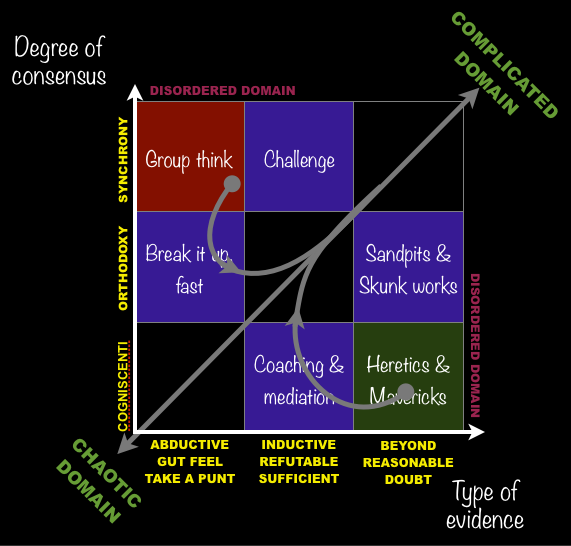There is a growing interest among enterprise architects in systems theory or thinking. (In this context, the words "theory" and "thinking" seem to be for all intents and purposes interchangeable.) There are several possible reasons for this interest.
1. The idea that systems thinking provides some theoretical underpinning for enterprise architecture and/or systems architecture.
2. The idea that systems thinking is somehow complementary to enterprise architecture, and that there is some kind of synergy available from putting together concepts, techniques and practices from the two disciplines.
3. The idea that systems thinking and enterprise architecture are essentially doing the same things (modelling, abstraction, joined-up thinking, big picture, enterprise-as-system, etc etc)
4. The idea that systems thinking and enterprise architecture are rivals for our affections, and their respective champions are trying to show that one is more conceptually coherent, more broadly based, more solidly grounded, and even perhaps more useful, than the other.
Both Enterprise Architecture (EA) and Systems Thinking (ST) have some espoused theory - in other words, things that both practitioners and researchers believe to be true. There are many different schools of EA and ST, and each school has a different set of beliefs, as well as a different set of concepts. Indeed, different schools may have widely different notions of what an enterprise or system actually is.
But EA and ST are not just random collections of theory but practices, offering a range of practical tools and techniques. These practices are instrumental, by which I mean that they are used by practitioners in order to perform some function, as a means to some defined set of ends, delivering something of value for some stakeholders. There is considerable debate in both the EA community and in the ST community as to what these ends are, and for whom. For example, some may think that the primary task of EA or ST is to describe and specify stuff, or to deliver understanding and insight. Others may think that the primary task is to plan and manage some kinds of change.
Practitioners may explain what they do, and why they think it works, but we shouldn't always take these explanations at face value. Espoused theory may not reflect theory-in-use. Thus although an EA practitioner and an ST practitioner may use different concepts to explain what they do. and may appeal to different authorities, what they actually do in real situations might possibly turn out to be pretty similar. The real test of similarity or difference between EA and ST would be observing what they actually do, and comparing the concrete conclusions and recommendations they produce, rather than listening to their various reasons and rationalizations.
Besides conceptual differences, practitioners may adopt a range of different stances towards the problem space. The classic EA stance is a visionary one - formulating an optimistic vision or blueprint of some desired future state. Whereas the classic ST stance may be a more realistic one - identifying the difficulties and risks in some elaborate plan. We can map these two positions to the opposite poles identified in Albert Hirschman's book
The Rhetoric of Reason.
On the one hand, an optimistic and progressive stance (EA-as-visionary)
- Urgent action is necessary to avoid imminent danger ("The Imminent Danger")
- All reforms work together and reinforce each other, rather than being competing ("The Synergy Illusion")
- History Is on Our Side
On the other hand, a more conservative or reactionary stance (ST-as-realist)
- Any purposive action to improve some feature of the political, social, or economic order only serves to exacerbate the condition one wishes to remedy. ("perversity thesis")
- Attempts at social transformation will be unavailing, that they will simply fail to "make a dent." ("futility thesis")
- The cost of the proposed change or reform is too high as it endangers some previous, precious accomplishment. ("jeopardy thesis")
From a conservative or reactionary stance, the optimistic stance of the EA-as-visionary seems naive and possibly dangerous. However, the reactionary stance is also problematic, and Hirschman regarded the standard reactionary objections to all proposals for change as stupefying, mechanical, hyperbolic, and often wrong. See Cass R. Sunstein,
An Original Thinker of Our Time (New York Review, May 2013).
We may observe that EAs with a strong appreciation of systems thinking often adopt an EA-as-realist position. Meanwhile, these are not the only possible stances for EA or ST. A number of other possible stances were identified in a workshop at EAC2009. At the time, these were called archetypes, as in my post
EA Archetypes (June 2009).
And there are undoubtedly different ST stances as well. A common stance within ST is the Critical Diagnostic: here's why this can never work. Applies both to AS-IS (explaining the dysfunctional behaviour of existing systems) and TO-BE (pointing out the flaws in proposed interventions). This is perhaps fairly close to the EA-as-Realist stance.
Another common stance within ST is the Critical Doctrine: here's why so-and-so's approach doesn't count as true Systems Thinking. Applied by nearly everyone against the Seddonites, and by the Checklanders against nearly everyone.
Undoubtedly the ability of EA and ST to work together depends (among other things) on the stances involved.
Meanwhile, those offering a conceptual unification between EA and ST either have a much harder challenge (if they wish to account for the detailed differences in outcomes between EA and ST practice) or a trivially easy challenge (if they confine themselves to asserting broad generalities and abstract principles).
See my previous post
How to combine Enterprise Architecture with Systems Thinking (Jan 2011)
Updated 14 May 2013
